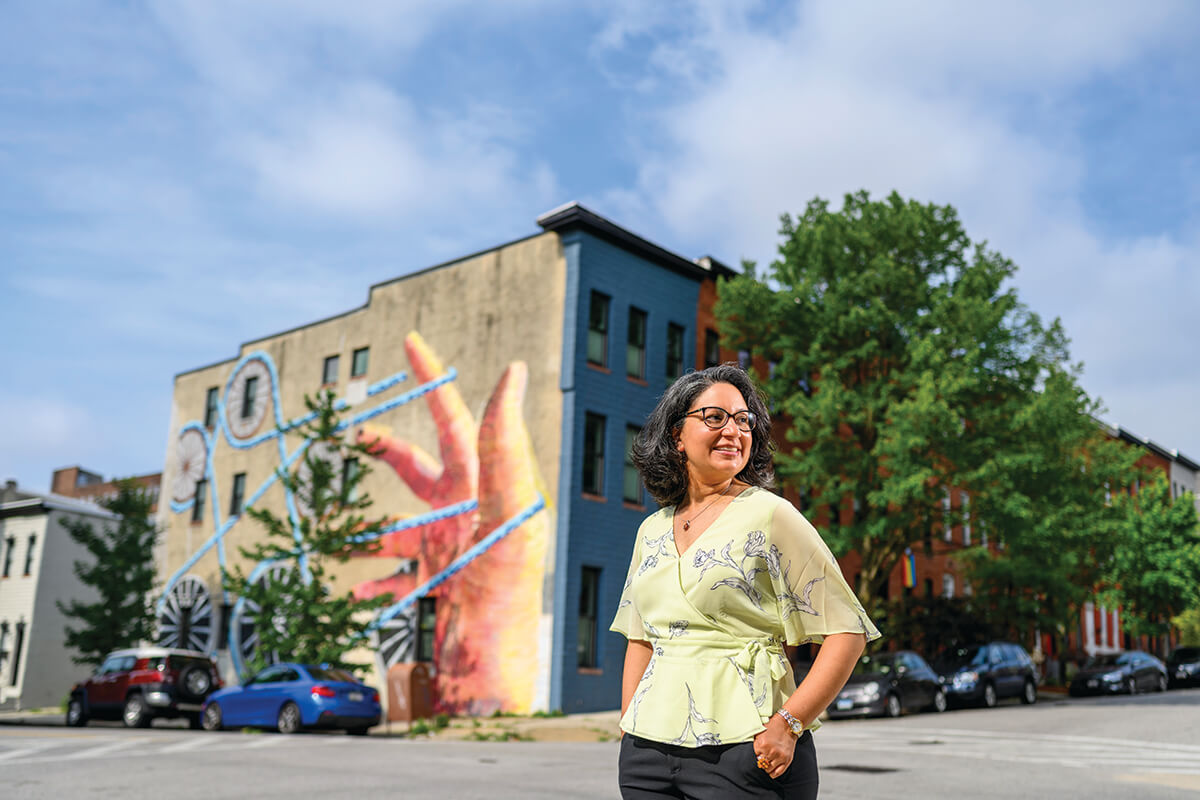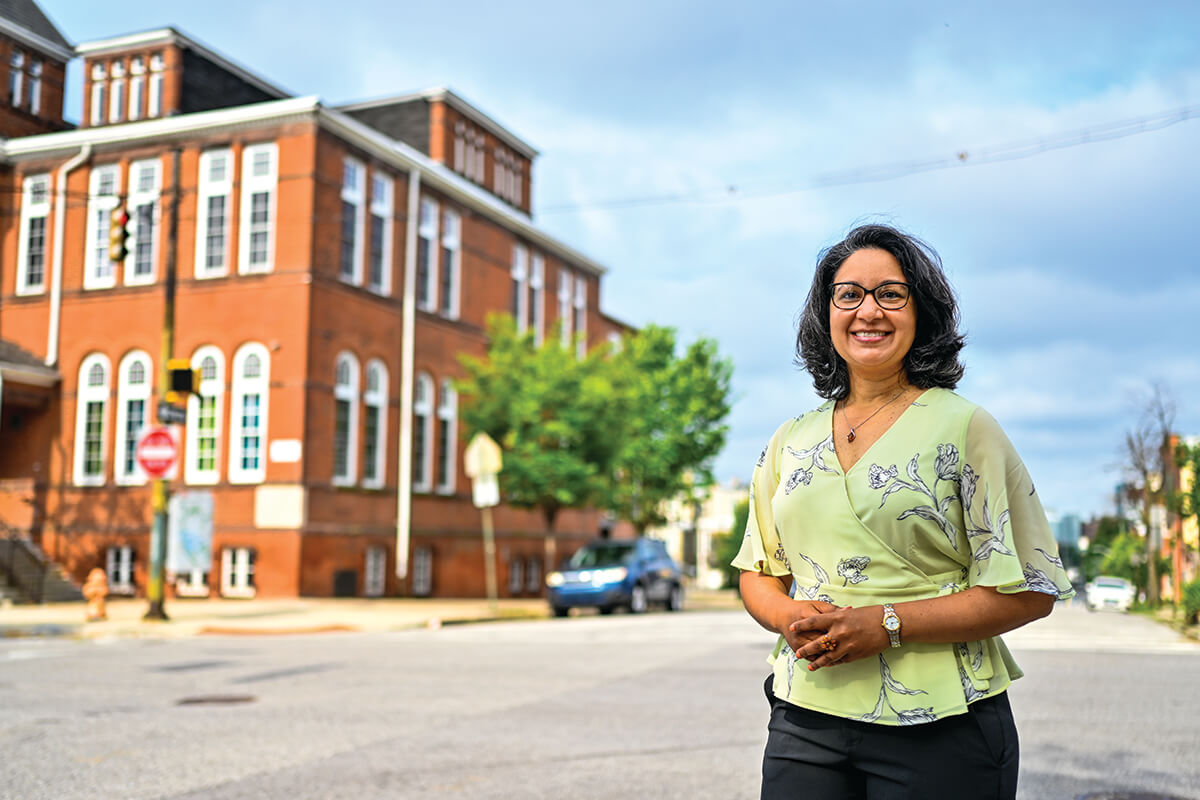GameChangers
Seema D. Iyer is Improving Local Neighborhoods One Micro-Metric at a Time
Annual report by the Baltimore Neighborhood Indicators Alliance aims to address community problems head on.

For more than 20 years, the Baltimore Neighborhood Indicators Alliance (BNIA) has tracked neighborhood data, everything from crime statistics to how many trees are on a given street. It began under the leadership of Odette Ramos (now a City Council member) with seed funding from the Annie E. Casey Foundation. The idea then was to gather data for nonprofit organizations working in Baltimore City to track the efficacy of their programs. Every year, BNIA publishes its data in “Vital Signs.” Since 2011, the project has been overseen by Seema D. Iyer, who is on a statistical mission to improve Baltimore’s neighborhoods one micro-metric at a time.
Explain how BNIA began.
Neighborhoods had been rapidly declining for a long time. Then in the late 1990s, e-government was coming into existence. That confluence of electronic information and ways to compute it using geographic mapping systems created an “Aha” moment. What if we actually took all this data, integrated it, and put it out for people to see what was happening in the neighborhoods?
What is the value of tracking neighborhood data?
It isn’t just about who called 911 on 301 Main Street. It’s about what that means. One of the best examples was people were calling 311 every time they saw water trickling in a certain neighborhood. That could lead to sewer backups and possible basement flooding, which could impact the housing stock. If you look at that data continuously, you can often see early warning signs. The key is to track things routinely over time—the trend is what really matters.
How has BNIA and its Vital Signs report changed over two decades?
The first decade was really about, “What do you want to know about your neighborhood?” It was the first time people were even asked that question. In 2011, when I moved over to BNIA, we had just published our 10th “Vital Signs” compendium of data and I realized in our second decade the key was not just to put the data out there, but to tell a story with that data. We’ve gotten good at putting the information out to anyone who needs it, but, more importantly, we’ve gotten better at telling the story of, for example, what it means if your neighborhood has a high vacancy rate. In order to tell that story, we’ve gotten to know our communities. We present to neighborhoods and community associations every year, like a doctor giving an annual checkup.
Can you provide an example of that community outreach in action?
In doing this outreach to communities, we had a neighborhood that said there were too few vacancies being reported on the “Vital Signs” report. So they went to the housing department and the housing department actually went on a walk with that community. The next year, they saw an increase in vacancy reporting. The fact that there was an increase in vacancy wasn’t a good thing, but the fact that they could tell their story accurately, that they could say the neighborhood needed help, that was what they wanted and what they got. We’ve created a way for communities to connect with their government to improve their own neighborhoods.

You track over 100 indicators annually—vacancy rates, number of children in public schools, crime—but it gets pretty granular. What are some of your favorite metrics?
In 2011, we realized we didn’t have quality-of-life metrics, like how much open space is in your neighborhood or air and water quality. Those are indicators that the community is a good steward of the neighborhood. We created a new chapter called “sustainability.” The other one we created is “arts & culture,” things you can do in your neighborhood that bring people together. There has to be a mechanism to get know each other.
My favorite data set is a partnership we started with the Enoch Pratt Free Library. We now know how many people in your neighborhood have a library card. The reason this is such an important indicator is we know what it means—it means a lot for early literacy, which is so important for life success later on; it means a lot as a place where people access information, go to talks, get books; and it has mean- ing for Internet access and job searching. And it’s such an actionable indicator. If you see that rate in your neighborhood is low, you can put out a card table on your street and have a get-carded event.
IT’S NOT ENOUGH TO PUT OUT THIS INFORMATION…WE WANT TO ADDRESS PROBLEMS HEAD ON WITH INFORMATION THAT CAN REALLY HELP US MOVE THE NEEDLE.
It’s been 21 years. How is BNIA improving quality of life in Baltimore?
I came in 2011 and I loved putting out the data, and then Freddie Gray happened in 2015. And it happened right outside our window—we’re located less than a mile from the CVS that burned. We saw the protests on Charles Street. It was personally devastating because I thought, “What’s the purpose of our work if we can’t prevent things like this?” As I mentioned, it’s all about the early warning signs and you could see them. We had seen vacancy in Sandtown-Winchester consistently rising since 2000. In 2015, it was our number-one neighborhood for vacant and abandoned housing. We all did a lot of soul-searching: It’s not enough to put out this information, it’s not enough to go to community meetings and tell people, we have to do more. We want to address problems head on with information that can really help us move the needle.
What’s the future of BNIA?
We at BNIA know a lot of stuff. We’re looking at how we can impart that knowledge in a systemic way and train the next generation of data scientists. And we’re trying to get to the root cause of our neighborhood problems since 2015. That meant getting out of our comfort zone. We usually interact with city government and community associations. Before, we didn’t really interact with advocacy groups, like those involved in affordable housing, and didn’t really interact with the media. Now we do. If I see something in the media that’s inaccurately describing our city using our data, I will actually go hunt down that reporter. We’re like data vigilantes!